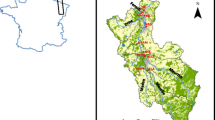Abstract
Suspended sediments collected during rain events were analysed to assess the maximum potential bioavailability of particulate phosphorus (PP). Physical (separation by particle size) and chemical (sequential extraction) fractionation techniques were applied. Time differentiated sampling during rain events revealed that changes in the concentrations of soluble and particle bound phosphorus, and in the proportion of different PP phases, are due to the changing contribution of various sources of runoff and to flow related variations in particle size. Size fractionation and the extraction of PP phases, can help to distinguish resuspended sediments from sediments coming directly from outside the channel. In light of a former study, investigating PP sedimentation and transformations within the sediments of Lake Sempach, our results lead to the conclusion that, at least 25% (particulate inorganic and reductive soluble P) and at most 70% of the allochthonous PP supply transported during a single rain event, may become bioavailable after early diagenesis in the lake sediments. The uncertainty is due to the unknown time span necessary for the diagenesis, at the lake sediment surface, of particulate organic phosphorus of allochthonous origin.
Similar content being viewed by others
References
Baldwin DS (1996) Effects of exposure to air and subsequent drying on the phosphate sorption characteristics of sediments from a eutrophic reservoir. Limnol. Oceanogr. 41: 1725-1732
Belzille N, Pizarro J, Filella M & Buffle J (1996) Sediment diffusive fluxes of Fe, Mn and P in a eutrophic lake: Contribution from lateral vs bottom sediments. Aquat. Sci. 58: 327-354
Brook EJ & Moore JN (1988) Particle-size and chemical control of As, Cd, Cu, Fe, Mn, Ni, Pb, and Zn in bed sediment from the Clark Fork river,Montana (U.S.A.). Sci. Tot. Environ. 76: 247-266
Chambers RM & Odum WE (1990) Porewater oxidation, dissolved phosphate and the iron curtain. Biogeochem. 10: 37-52
Chase EM & Sayles FL (1980) Phosphorus in suspended sediments of the Amazon River. Estuarine Coastal Shelf Sci. 11: 383-391
Cuker BE, Gama PT & Burkholder JM (1990) Type of suspended clay influences lake productivity and phytoplankton community response to phosphorus loading. Limnol. Oceanogr. 35: 830-839
De Pinto JV, Young TC & Martin SC (1981) Algal-available phosphorus in suspended sediments from lower Great Lakes tributaries. J. Gr. Lakes Res. 7(3): 311-325
Dorich RA, Nelson DW & Sommers LE (1980) Algal availability of sediment phosphorus in drainage water of the Black Creek watershed. J. Environ. Qual. 9: 557-563
Dorich RA, Nelson DW & Sommers LE (1985) Estimating algal available phosphorus in suspended sediments by chemical extraction. J. Environ. Qual. 14: 400-405
Dorioz JM, Pilleboue E & Fehri A (1989) Dynamique du phosphore dans les bassins versants: importance des phénomènes de rétention dans les sédiments. Wat. Res. 23(2): 147-158
Ekholm P (1994) Bioavailability of phosphorus in agriculturally loaded rivers in southern Finland. Hydrobiol. 287: 179-194
Fabre A, Qotbi A, Dauta A & Baldy V (1996) Relation between algal available phosphate in the sediments of the River Garonne and chemically-determined phosphate fractions. Hydrobiol. 335: 43-48
Foster ID, Owens PN & Walling DE (1996) Sediment yields and sediment delivery in the catchments of Slapton Lower Ley, South Devon, U.K. Field Studies 8: 629-661
Gächter R & Stadelmann P (1993) Gewässerschutz und Seeforschung. Mitt. Naturforsch. Gesell. Luzern 33: 343-378
Gächter R, Mareš A, Stamm C, Kunze U & Blum J (1996) Dünger düngt Sempachersee. Agrarforsch. 3: 329-332
Golterman HL (1976) Sediments as a source of phosphate for algal growth. In: Golterman HL (Ed) Interactions between Sediments and Freshwater (pp 286-293). Proceedings of an international symposium held in Amsterdam, The Netherlands
Gonsiorczyk T, Casper P & Koschel R (1997) Variations of phosphorus release from sediments in stratified lakes. Wat. Air and Soil Poll. 99: 427-434
Horowitz AJ (1991) A Primer on Sediment-Trace Element Chemistry, 2nd rev. edn. Lewis Publishers Inc., Chelsea MN
Hupfer M, Gächter G & Giovanoli R (1995) Transformation of phosphorus species in settling seston and early sediment diagenesis. Aquat. Sci. 57(4): 305-324
Hubbard RK, Erikson AE, Ellis BG & Wolcott AR (1982) Movement of diffuse source pollutants in small agricultural watersheds of the Great Lakes Basin. J. Environ. Qual. 11: 117-123
Johnson AH, Bouldin DR, Goyette EA & Hedges AM (1976) Phosphorus loss by stream transport from a rural watershed: Quantities, processes and sources. J. Environ. Qual. 5: 148-157
Kobler D & Boller M (1997) Particle removal in different filtration systems for tertiary wastewater treatment — A comparison. Wat. Sci. Tech. 36: 259-267.
Logan TJ, Oloya TO & Yaksich SM (1979) Phosphate characteristics and bioavailability of suspended sediments from streams draining into lake Erie. J. Gr. Lakes Res. 5: 112-123
Mayer TD & Jarrell WM (1996) Assessing colloidal forms of phosphorus and iron in the Tualatin river basin. J. Environ. Qual. 24: 1117-1124
Miller MH, Robinson JB, Coote DR, Spires AC & Draper DW (1982) Agriculture and water quality in the Canadian Great Lakes Basin, III. Phosphorus. J. Environ. Qual. 11: 487-493
Müller C, Gächter R, Pacini N & Kobler D (submitted) Discharge dependent aggregate size distributions in a small river. Wat. Res.
Pacini N, Harper DM & Mavuti KM (1993) A sediment-dominated tropical impoundment: Masinga Dam, Kenya. Verh. Internat. Verein. Theor. Angewandte Limnol. 25: 1275-1279
Pacini N (1994) Coupling of land and water: phosphorus fluxes in the upper Tana River catchment. PhD Thesis, University of Leicester (U.K.)
Paludan C & Jensen HS (1995) Sequential extraction of phosphorus in freshwater wetland and lake sediment: Significance of humic acids. Wetlands 15(4): 365-373
Pionke HB & Kunishi HM (1992) Phosphorus status and content of suspended sediment in a Pennsylvania watershed. Soil Sci. 153(6): 452-462
Psenner R & Pucsko R (1988) Phosphorus fractionation: Advantages and limits of the method for the study of sediment P origins and interactions. Archiv Hydrobiol. Beih. Ergeb. Limnol. 30: 43-59
Psenner R, Boström B, Dinka M, Petterson K, Pucsko R & Sager M (1988) Fractionation of phosphorus in suspended matter and sediment. Archiv Hydrobiol. Beih. Ergeb. Limnol. 30: 98-110
Ruttenberg CK (1992) Development of a sequential extraction method for different forms of phosphorus in marine sediments. Limnol. Oceanogr. 37(7): 1460-1482
Sas H (1989) Lake Restoration by Reduction of Nutrient Loading: Expectations, Experiences, Extrapolations. Academia Verlag, Sankt Augustin, Germany
Sharpley AN, Menzel RG, Smith SJ, Rhoades ED & Olness AE (1981) The sorption of soluble phosphorus by soil material during transport from cropped and grassed watersheds. J. Environ. Qual. 10: 211-215
Stabel H-H & Geiger M (1985) Phosphorus adsorption to riverine suspended matter. Water Res. 19: 1347-1352
Stone M & Mudroch A (1989) The effect of particle size, chemistry and mineralogy of river sediments on phosphate adsorption. Environ. Techn. Lett. 10: 501-510
Stone M & English MC (1993) Geochemical composition, phosphorus speciation and mass transport of fine-grained sediment in two Lake Erie tributaries. Hydrobiol. 253: 17-29
Twinch AJ (1987) Phosphate exchange characteristics of wet and dried sediment samples from a hypertrophic reservoir: Implications for the measurement of sediment phosphorus status. Water Res. 21: 1225-1230
Vaithiyanathan P & Correll DL (1992) The Rhode River watershed: Phosphorus distribution and export in forest and agricultural soils. J. Environ. Qual. 21: 280-288
Viner AB (1982) A quantitative assessment of the nutrient phosphate transported by particles in a tropical river. Rev. Hydrobiol. Trop. 15: 3-8
Walling DE (1996) Suspended sediment transport by rivers: A geomorphological and hydrological perspective. Archiv. Hydrobiol. Special Issues, Adv. Limnol. 47: 1-27
Weiner BB (1984) Modern methods of particle size analysis. In: Barth HG (Ed). John Wiley & Sons
Williams DH, Shear H & Thomas RL (1980) Availability to Scenedesmus quadricauda of different forms of phosphorus in sedimentary materials of the Great Lakes. Limnol. Oceanogr. 25: 1-11
Author information
Authors and Affiliations
Rights and permissions
About this article
Cite this article
Pacini, N., Gächter, R. Speciation of riverine particulate phosphorus during rain events. Biogeochemistry 47, 87–109 (1999). https://doi.org/10.1023/A:1006153302488
Issue Date:
DOI: https://doi.org/10.1023/A:1006153302488




